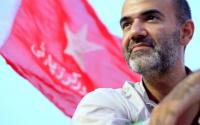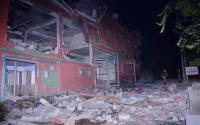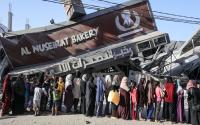One incident. Forty dead. Two stories. What really happened?
Justin Huggler in Baghdad21 May 2004
A tiny bundle of blankets is unwrapped; inside is the body of a baby, its limbs smeared with dried blood. Then the mourners peel back the blanket further to reveal a second dead baby.
Another blanket is opened; inside are the bodies of a mother and child. The child, six or seven years old, is lying against his or her mother, as if seeking comfort. But the child has no head.
These are the images that American forces in Iraq had no answer to yesterday. They come from video footage of the burials of 41 men, women and children. The Iraqis say they died when American planes launched air strikes on a wedding party near the Syrian border on Wednesday.
US forces insist that the attack was on a safe house used by foreign fighters entering Iraq from Syria. They do not dispute that they killed about 40 people, but claim American forces were returning fire and the dead were all foreign fighters. For the video footage that shows dead women and children they have no explanation.
So potentially damaging is the video to the US occupation that American officials have demanded that the Dubai-based al-Arabiya television news network, which obtained the footage, give them the name of the cameraman who took it. Al-Arabiya has refused.
In the footage men weep and cling to the bodies of their loved ones before they are buried. There are dozens of bundles wrapped in flower-patterned blankets. Some of these images were shown on Western television news yesterday, but not the most disturbing: the bodies themselves.
"These were more than two dozen military-age males. Let's not be naive," Major General James Mattis, commander of the US 1st Marine Division, said. But he had no explanation of where the dead women and children in the video came from. "I have not seen the pictures but bad things happen in wars," he said cryptically. "I don't have to apologise for the conduct of my men."
US forces say they have been watching the border area where the attack took place for some time. They saw a large group of suspicious people moving in the area and sent in ground forces, who came under fire, so the US forces returned fire.
They are sticking doggedly to this version of events despite growing evidence that a wedding party was hit. More and more eyewitnesses are coming forward. Hussein Ali, a well-known wedding singer, was buried in Baghdad yesterday, alongside his brother Mohammed. Their family said they had been performing at the wedding.
The evidence that the US military has put forward to support its version of events has been seriously undermined. Brigadier General Mark Kimmitt said guns, Syrian passports and a satellite phone had been recovered. But Sheikh Nasrallah Miklif, the head of the Bani Fahd tribe to which most of the dead belonged, said that was to be expected, given that the air strike happened in Makradheeb, a village in the desert, about 10 miles from the Syrian border.
Every household in Iraq has a gun, usually a Kalashnikov assault rifle, to protect itself. In the desert it is even more common for people to keep guns, as protection not only from robbers, but also wild animals. Shepherds need to protect their flocks.
The village is 80 miles from the nearest town, al-Qa'im, and 10 miles from the nearest road. There are no telephone lines and no mobile coverage. Satellite phones are comparatively cheap in Iraq and it would be surprising if the villagers did not have one.
People in the area frequently marry neighbours from across the border. That means there have always been villagers on the Iraqi side with Syrian passports and vice versa. On top of that, many of the villagers on both sides make their living smuggling sheep across the border, and have been routinely crossing it for years - not entirely legal, but that does not make them foreign fighters planning to attack US forces.
General Mattis asked: "How many people go to the middle of the desert 10 miles from the Syrian border to hold a wedding 80 miles from the nearest civilisation?" Iraqis replied that the victims of the attack were holding the wedding in the village where they had lived all their lives.
Sheikh Mikfil was not in the village at the time of the attack, but he has spoken at length with the survivors. All of the villagers were members of his tribe; the only dead from outside were the musicians. He put the death toll at 41 - 25 of whom were members of the bridegroom's family. The wedding was held at the home of the bridegroom's father, Rikat Obeid Hussein. The newly married couple survived because they were in a specially erected honeymoon tent when the bombing began.
The sheikh said that by 2am, when the attack started, the celebrations were finished and the guests were asleep. There had been US helicopters in the sky earlier, but they had not fired and the wedding guests were not worried.
General Kimmitt said: "We sent a ground force in to the location. They were shot at. We returned fire."
But Sheikh Mikfil said the attack began with air strikes, without warning. They were followed by helicopters, and after several hours of air strikes, US troops arrived in armoured vehicles to search the devastated village.
Contrary to earlier reports, the sheikh said, there was no celebratory gunfire. Firing guns in the air is traditional at Iraqi weddings, and it was initially suspected that US forces had mistaken such shooting for hostile fire, as they did at a wedding party in Afghanistan when US air strikes killed more than 50 people in 2002. Sheikh Mikfil says he questioned the survivors extensively on this, and they were categorical: there was no shooting in the air.
He said the bride came from the same village, so there was no large-scale movement of people that could have aroused US suspicions. "If they killed foreign fighters, why don't they show us the bodies?" he asked. "If they suspected foreign fighters were there, why didn't they come to arrest them, instead of using this huge force?"
Sheikh Mikfil said he suspected the Americans might have been acting on false intelligence information, given by someone who wanted to increase the tension between Iraqis and Americans.
It is impossible to reconcile the American and Iraqi versions of events. But with more and more evidence emerging that casts doubt on the American version, and Iraqi anger rising, US forces need to come up with some answers. If this was one of the "bad things" that "happen in wars" - to use General Mattis's phrase - more explanation is required.






